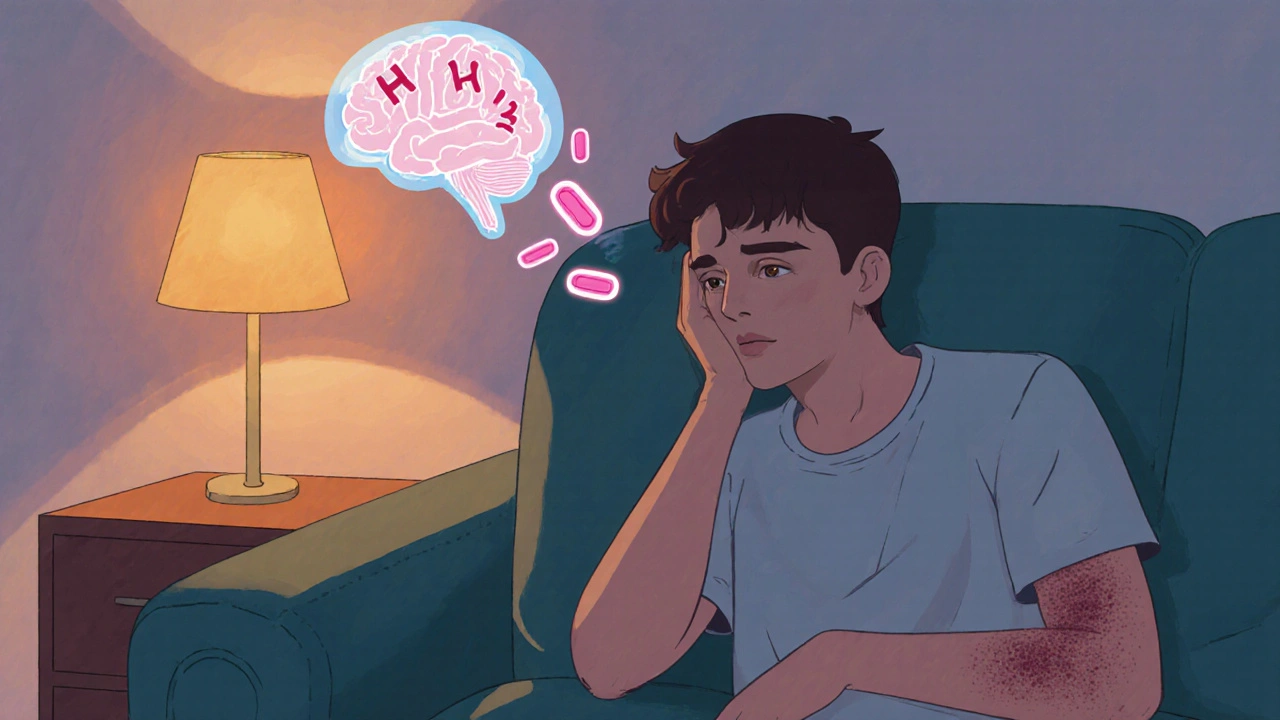
Atarax (Hydroxyzine) Alternative Selector
Find Your Best Alternative
Select your primary concern and preferences to see which medication might be most appropriate for you.
Recommended Alternative
Why this option?
Key Benefits
Common Side Effects
When you pick up a prescription for Atarax, you might wonder how it stacks up against other meds you’ve heard about. Is it the right choice for anxiety, itching, or sleep? Below we break down the key facts, side‑effects, and typical uses of Atarax and several common alternatives so you can decide what fits your needs.
What is Atarax (Hydroxyzine)?
Hydroxyzine is a first‑generation antihistamine that works by blocking H1 receptors in the brain and peripheral tissues. It’s marketed under the brand name Atarax for anxiety, pruritus, and as a sedative before surgery.
Because it crosses the blood‑brain barrier, hydroxyzine can calm nerves while also relieving itchy skin. Typical adult doses for anxiety start at 25 mg up to three times a day, whereas for itching a single 25 mg dose may be enough.
Why compare Atarax with other drugs?
Patients often face a menu of options: other antihistamines for itching, benzodiazepines for anxiety, or even over‑the‑counter sleep aids. Each class has its own onset speed, duration, and side‑effect profile. Comparing them side‑by‑side helps you avoid unwanted drowsiness, dependence, or interactions.
Key dimensions for comparison
- Drug class - Determines how the medication works.
- Primary indication - What condition it’s approved for.
- Typical dose range - Helps you gauge how much you’ll be taking.
- Onset of action - How fast you feel relief.
- Half‑life - Influences how long effects last.
- Common side effects - What to watch for.
Comparison table
| Drug | Class | Primary Use | Typical Dose | Onset | Half‑Life | Common Side Effects |
|---|---|---|---|---|---|---|
| Hydroxyzine (Atarax) | First‑gen antihistamine | Anxiety, itching, sedation | 25‑100 mg PO q6‑8h | 30‑60 min | 20‑25 h | Drowsiness, dry mouth, headache |
| Diphenhydramine (Benadryl) | First‑gen antihistamine | Allergy, insomnia | 25‑50 mg PO q4‑6h | 15‑30 min | 4‑6 h | Heavy sedation, anticholinergic effects |
| Cetirizine (Zyrtec) | Second‑gen antihistamine | Allergic rhinitis, urticaria | 10 mg PO daily | 1‑2 h | 7‑10 h | Mild drowsiness, headache |
| Alprazolam (Xanax) | Benzodiazepine | Generalized anxiety, panic | 0.25‑0.5 mg PO q6‑8h | 15‑30 min | 11‑12 h | Dependence, withdrawal, drowsiness |
| Lorazepam (Ativan) | Benzodiazepine | Anxiety, insomnia | 0.5‑1 mg PO q12h | 30‑60 min | 10‑20 h | Tolerance, sedation, memory issues |
| Melatonin | Hormone supplement | Sleep onset | 0.5‑5 mg PO nightly | 30‑60 min | 30‑60 min | Daytime grogginess (rare) |
| Doxepin | Tricyclic antidepressant | Insomnia, itching | 3‑6 mg PO nightly (low dose) | 1‑2 h | 15‑18 h | Dry mouth, weight gain, cardiac risk at high dose |
| Trazodone | Atypical antidepressant | Insomnia | 50‑100 mg PO nightly | 30‑60 min | 6‑9 h | Orthostatic hypotension, priapism (rare) |
| Zolpidem (Ambien) | Non‑benzodiazepine hypnotic | Sleep initiation | 5‑10 mg PO nightly | 15‑30 min | 2‑3 h | Complex sleep behaviours, next‑day drowsiness |
How Atarax measures up
Based on the table, hydroxyzine shines in three areas:
- Dual action: It treats both anxiety and pruritus, something most antihistamines can’t do.
- Long half‑life: A single dose can cover a full day, reducing the need for multiple tablets.
- Lower abuse potential than benzodiazepines, making it a safer long‑term option for many patients.
However, the trade‑offs are clear:
- It can cause noticeable drowsiness, which may be undesirable for daytime use.
- Anticholinergic side effects (dry mouth, constipation) appear more often than with second‑gen antihistamines like cetirizine.
- Onset is slower than diphenhydramine, so it’s not ideal for rapid‑acting allergy relief.
Choosing the right alternative
If your main issue is nighttime itching, hydroxyzine might be the top pick because it keeps you sedated long enough to sleep through the night. But if you need a quick antihistamine for a sudden rash, diphenhydramine’s 15‑minute kick starts faster.
For pure anxiety without itching, a low‑dose benzodiazepine such as alprazolam works faster, yet it carries a risk of dependence. In such cases, clinicians sometimes start with hydroxyzine as a bridge while evaluating non‑pharmacologic therapy.
When insomnia is the sole complaint, melatonin offers a natural approach with minimal side effects, while prescription hypnotics like zolpidem provide stronger sleep induction but may cause “sleep‑walking” episodes.
Safety considerations and drug interactions
All the drugs listed are metabolised by the liver, often via CYP450 enzymes. Hydroxyzine, diphenhydramine, and cetirizine share the CYP3A4 pathway, so combining them with strong CYP3A4 inhibitors (e.g., ketoconazole) can raise blood levels and increase drowsiness.
Benzodiazepines are central nervous system depressants. Mixing them with any antihistamine, including Atarax, amplifies sedation and can impair driving. The FDA specifically warns against concurrent use of multiple sedating agents without medical supervision.
Pregnant or breastfeeding patients should avoid first‑generation antihistamines unless prescribed, as they cross the placenta and appear in breast milk. Alternatives like cetirizine are considered safer, but a doctor’s guidance is essential.
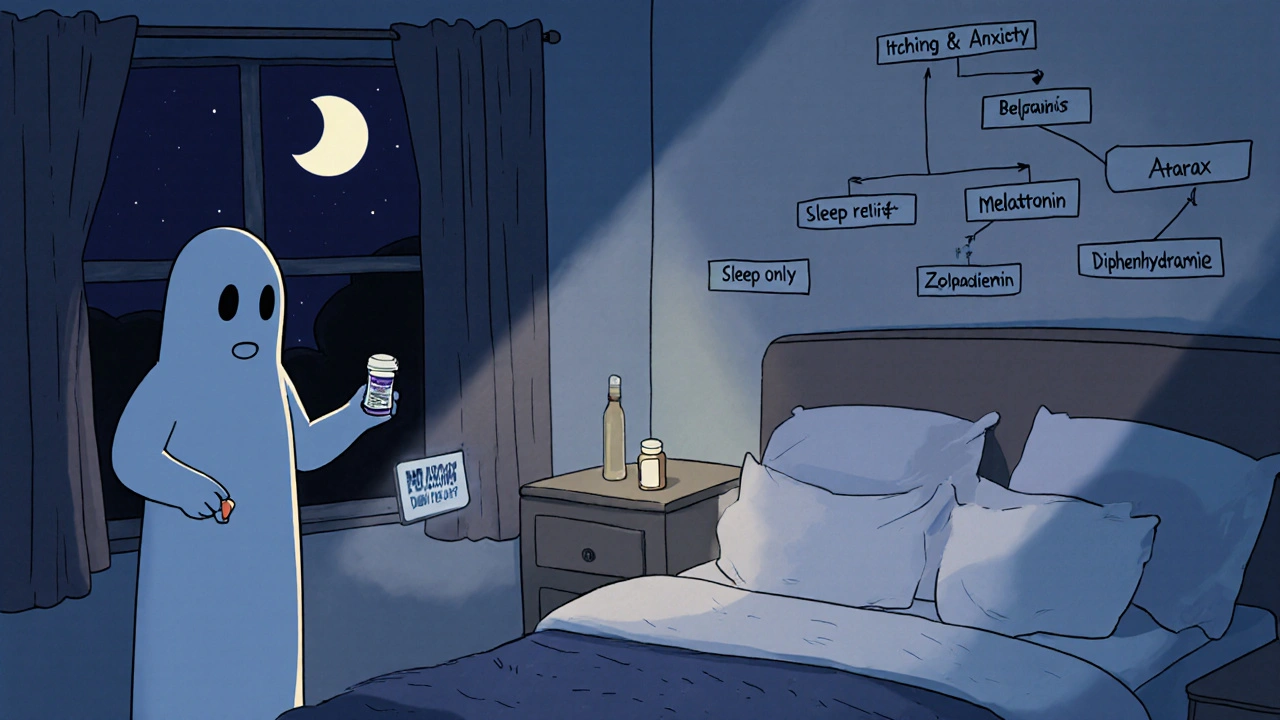
Practical tips for patients
- Start with the lowest effective dose of hydroxyzine and assess how drowsy you feel.
- Take Atarax in the evening if daytime alertness is important.
- Avoid alcohol; it intensifies sedation across all listed agents.
- Keep a medication log: note the time you take each dose, side effects, and how well symptoms improve.
- If you need an over‑the‑counter option for occasional itching, diphenhydramine works but reserve it for short‑term use.
When to see a healthcare professional
If you experience any of the following, schedule a check‑up:
- Persistent dry mouth that interferes with eating or speaking.
- Severe dizziness or fainting episodes.
- Signs of allergic reaction to the medication itself (rash, swelling, breathing difficulty).
- Difficulty sleeping more than two weeks despite using Atarax.
- Any thoughts of self‑harm-especially when using sedating drugs.
These symptoms may signal the need to switch to another class or adjust the dose.
Frequently Asked Questions
Is Atarax safe for long‑term use?
Hydroxyzine can be used long‑term for chronic itching or anxiety, but doctors usually monitor liver function and watch for increasing drowsiness. It has a lower risk of dependence than benzodiazepines, yet regular check‑ins are advised.
How does hydroxyzine differ from cetirizine?
Both are antihistamines, but hydroxyzine is a first‑generation drug that crosses the blood‑brain barrier, causing more sedation and also treating anxiety. Cetirizine is second‑generation, so it provides allergy relief with minimal drowsiness and does not address anxiety.
Can I combine Atarax with a benzodiazepine?
Combining two sedating agents raises the risk of excessive sleepiness, impaired coordination, and respiratory depression. It should only be done under close medical supervision, with doses adjusted accordingly.
What over‑the‑counter alternative works fastest for itch relief?
Diphenhydramine (Benadryl) usually starts acting within 15‑30 minutes, making it the quickest OTC option for acute itching. Keep in mind it can cause strong drowsiness.
Is melatonin a better sleep aid than hydroxyzine?
Melatonin mimics the body’s natural sleep hormone and carries low risk of next‑day grogginess, but its effect is modest. Hydroxyzine provides stronger sedation and also helps with itch, but it can leave you drowsy the next day. Choice depends on whether you need only sleep aid or dual relief.

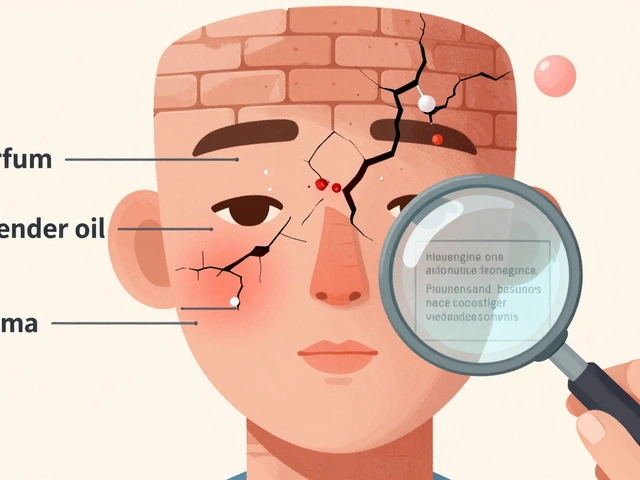
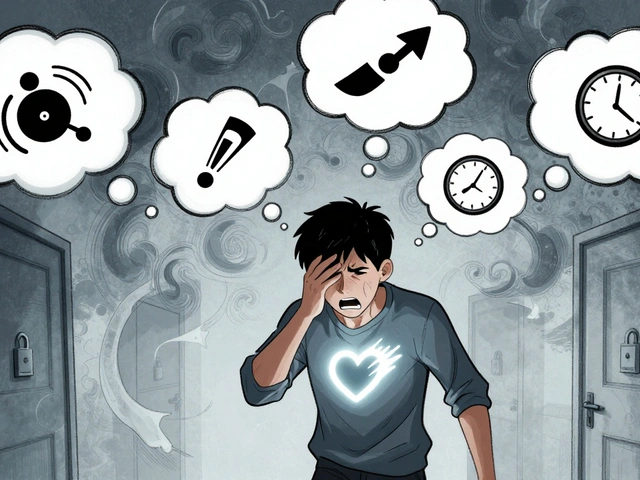

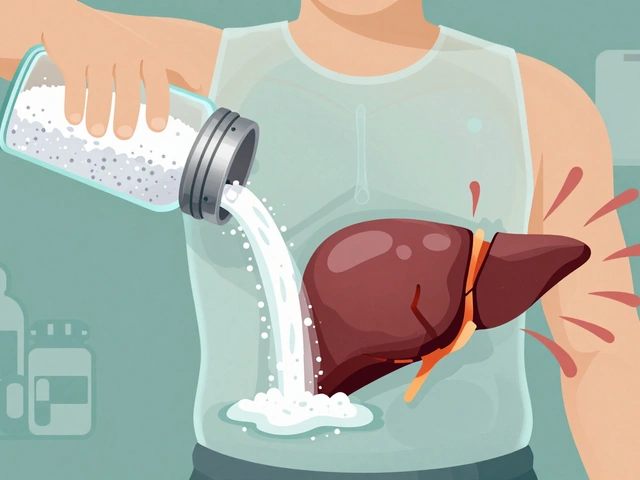

12 Comments
Yo fam, ever notice how the big pharma lobbyists push Atarax like it's the miracle cure while hiding the fact that it’s just another mind‑dulling sedative? They want us chilled out so we don’t question their pricing schemes, and they sprinkle in a dash of anxiety relief to keep us hooked on the next refill. The half‑life is long enough to keep you foggy for a whole day, perfect for a population that’s already programmed to be compliant. And don’t even get me started on the anticholinergic side effects-they’re basically a slow‑acting cognitive drain. Stay alert, read the fine print, and question why every new drug comes with a “warning: may cause drowsiness” label.
I appreciate the detailed perspective and understand the concerns about sedation and labeling. It’s important to weigh the benefits for anxiety or itching against those potential drawbacks. Consulting a healthcare professional can help balance these factors safely.
Let’s set the record straight: hydroxyzine is not some vague, interchangeable antihistamine. Its pharmacodynamics involve central H1 blockade, which is why it crosses the blood‑brain barrier and induces sedation-a property absent in second‑generation agents like cetirizine. If you’re looking for rapid itch relief, diphenhydramine outpaces Atarax by a wide margin, but at the cost of heavier anticholinergic burden. Moreover, the claim that its long half‑life is a universal advantage ignores the fact that excessive daytime drowsiness can impair productivity and safety. Ultimately, the choice hinges on whether you prioritize dual‑action anxiety control or pure, fast‑acting antihistaxis.
Thanks for sharing the info I think it helps a lot for anyone trying to decide what works best for them
Yep, good point 😊
Oh dear, if we’re to discuss Atarax we must first acknowledge the theatrical dance of the pharmaceutical aristocracy, who parade their “first‑generation antihistamines” as if they were the crown jewels of modern medicine. While the masses clutch their bottles like talismans against insomnia and itching, the sleight‑of‑hand persists: a sedative veil that masks the insidious drip of anticholinergic side effects. One cannot simply dismiss the elegance of a drug that doubles as anxiolytic, yet one must also question the spectacle of prescribing a sedative when a non‑sedating second‑gen antihistamine could suffice. In short, the drama lies not in the molecule itself but in the narrative woven around it by marketing maestros.
Great analysis, Tracy. From a pharmacotherapeutic standpoint, it’s crucial to consider the receptor affinity profile and the cytochrome P450 interactions when integrating hydroxyzine into a multimodal regimen. The dual antagonism at H1 and muscarinic receptors explains the observed sedation and anticholinergic load, which can be mitigated by dosage titration and timing of administration. Additionally, leveraging its anxiolytic properties as a bridge therapy while initiating SSRIs can optimize patient outcomes without abrupt withdrawal phenomena. Let’s keep the conversation evidence‑based and patient‑centered.
The pharmacokinetic parameters of hydroxyzine, notably its 20‑25 hour half‑life, render it suitable for once‑daily dosing in chronic pruritus management. However, clinicians must monitor for cumulative sedation, especially in polypharmacy scenarios.
Oh, brilliant, because we all love a good nap mid‑meeting. Nothing says “professional” like a patient drifting off after the fourth coffee.
Honestly you should start low and go slow it helps you see how your body reacts and you avoid the big drowsy crash
When it comes to titrating antihistamines such as hydroxyzine, the principle of “start low, go slow” is not merely a catchphrase but a cornerstone of rational pharmacotherapy, especially given the drug’s extensive half‑life and central nervous system penetration. Beginning with a 25 mg dose in the evening allows clinicians to observe the sedative effect without compromising daytime functionality, and it provides a clear baseline from which adjustments can be measured. If the patient reports lingering drowsiness the next morning, the dose can be reduced in 25 mg increments until a tolerable balance between itch relief and alertness is achieved. Conversely, if the therapeutic response is inadequate, a cautious upward titration to 50 mg may be warranted after a minimum of 48 hours, allowing steady‑state concentrations to stabilize. It is also critical to consider drug‑drug interactions; co‑administration with CYP3A4 inhibitors such as ketoconazole can amplify plasma levels, necessitating even more conservative dosing. Moreover, patient education plays a pivotal role: informing individuals about the potential for dry mouth, constipation, and the heightened risk of sedation when alcohol is consumed empowers them to make informed decisions. In practice, maintaining a medication diary can be invaluable, recording the exact timing of each dose, any side‑effects observed, and subjective measures of symptom relief. This systematic approach facilitates data‑driven discussions during follow‑up visits, allowing clinicians to fine‑tune the regimen based on real‑world outcomes. Additionally, assessing comorbid conditions such as obstructive sleep apnea is essential because the additive depressant effect of hydroxyzine could exacerbate nocturnal hypoventilation. For patients with a history of substance misuse, even the relatively low abuse potential of hydroxyzine must be weighed against the psychological reliance on sedative agents. In pediatric populations, the dosing guidelines differ significantly, and the margin for error narrows, underscoring the need for weight‑based calculations and vigilant monitoring. Ultimately, the goal is to achieve optimal pruritus control while preserving cognitive function, which requires a nuanced, patient‑centered titration schedule. By adhering to these evidence‑based principles, healthcare providers can maximize therapeutic benefit and minimize adverse outcomes.
In the quiet moments between dosing, one might contemplate how a molecule designed to quiet the mind paradoxically invites us to engage with the deeper currents of our own contemplation, a subtle reminder that medicine is as much an art as it is a science.